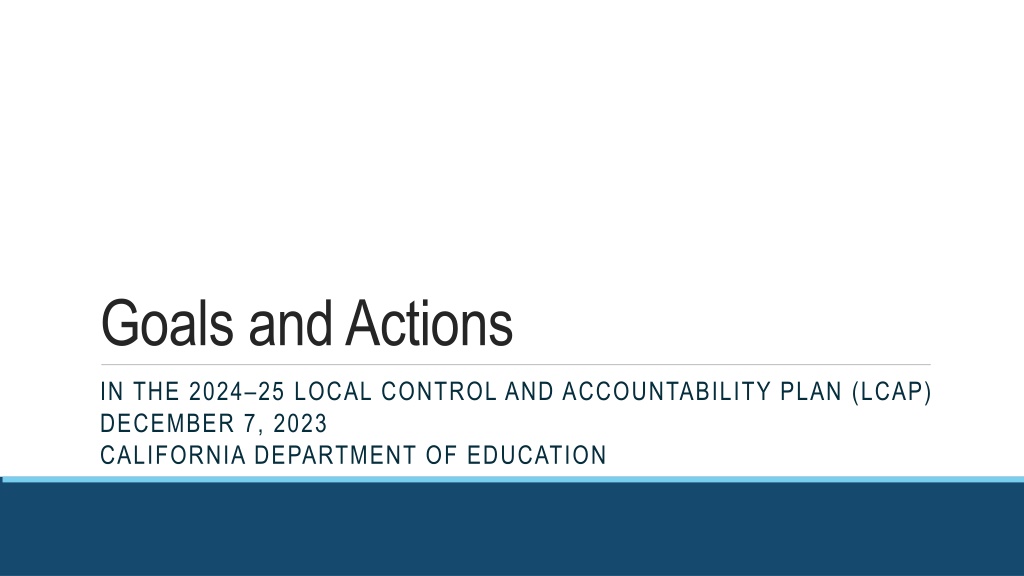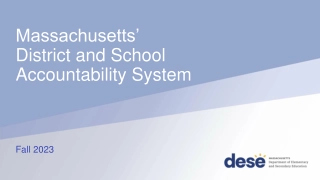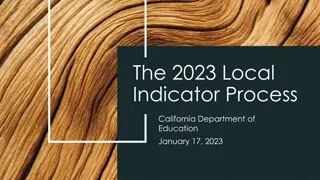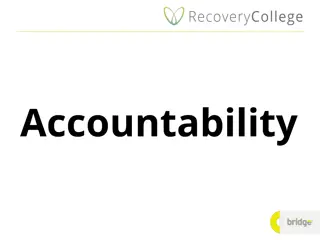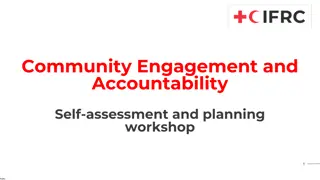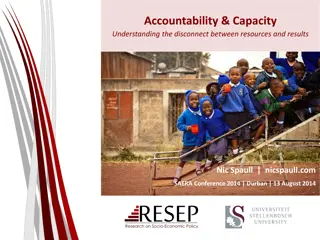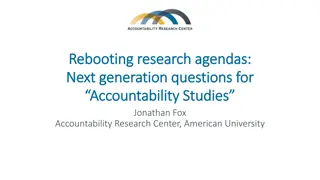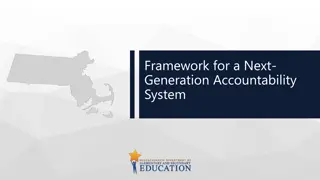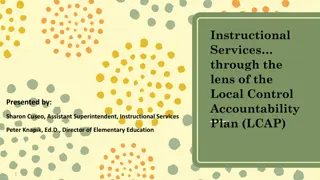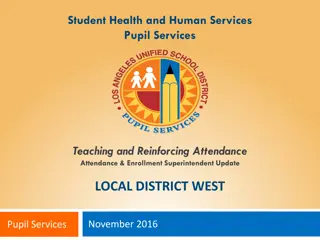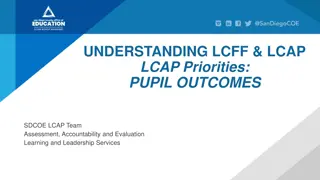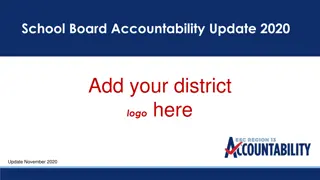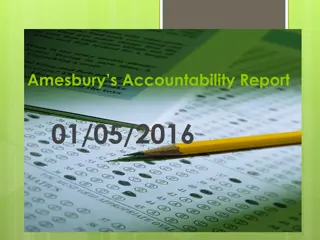2024-25 LCAP Goals and Actions Overview: Enhancing Educational Accountability
Delve into the 2024-25 Local Control and Accountability Plan (LCAP) through a series of webinars focusing on equity, services enhancement, and crucial elements for goal development. Explore templates and foundational information for a comprehensive understanding of the educational plan's requirements and objectives.
Download Presentation

Please find below an Image/Link to download the presentation.
The content on the website is provided AS IS for your information and personal use only. It may not be sold, licensed, or shared on other websites without obtaining consent from the author. Download presentation by click this link. If you encounter any issues during the download, it is possible that the publisher has removed the file from their server.
E N D
Presentation Transcript
Goals and Actions IN THE 2024 25 LOCAL CONTROL AND ACCOUNTABILITY PLAN (LCAP) DECEMBER 7, 2023 CALIFORNIA DEPARTMENT OF EDUCATION
Webinar Series TUESDAYS @ 2 THURSDAYS @ 3 December 12th: Required Goals for Equity Multiplier Schools December 14th: Increased or Improved Services, Part I December 19th: Increased or Improved Services, Part II January 9th: Local Indicators 2
Template Files 2023 24 LCAP Annual Update Template: https://www.cde.ca.gov/re/lc/documents/annualupdatetemplate2023.docx 2024 25 LCAP Template: https://www.cde.ca.gov/re/lc/documents/adoptedlcaptemplate2024.docx 2024 25 LCAP Action Tables Template: https://www.cde.ca.gov/re/lc/documents/lcapactiontables2024.xlsx The Budget Overview for Parents Template: https://www.cde.ca.gov/re/lc/documents/budgetoverviewparent.xlsx 3
Purpose The purpose of this session is to: 1. Review foundational information including the LCFF foundations, the three functions of the LCAP, etc. 2. Discuss the Goals and Actions section and associated requirements 3. Review important information for goal development 4
Topics Covered in Other Sessions The following topics will not be discussed today. Instead, they are discussed in other Tuesdays@2 sessions: The 2023-24 LCAP Annual Update Template Specifics of Equity Multiplier Goals The requirement to increase or improve services, specifics related to actions that contribute towards meeting the requirement to increase or improve services, and the Action tables related to the increase or improve services requirements and actions. 5
Intended Audience The intended audience for this presentation is anyone who will complete, review, or interact with the 2024 25 LCAP, including: Students Parents Teachers Staff Principals Administrators Advisory committees Members of governing boards or bodies Community members Local bargaining units (COEs and districts) 6
Foundational Principles of LCFF Local education agency (LEA)-level improvement is based on multiple measures of success, both communicated in the LCAP and the California School Dashboard. Equity: the principle of equity is operationalized through the goals, measures of progress, actions and descriptions included in the LCAP. (see notes) Subsidiarity: LEAs address local needs of students that have been identified through an analysis of data and input from educational partners utilizing flexible funding and communicate their efforts through the LCAP. (see notes) 8
LCAP Functions As part of the LCFF, LEAs are required to develop, adopt, and annually update a three-year LCAP using the template adopted by the California State Board of Education (SBE). The LCAP development process serves three distinct, but related functions: 1. Meaningful Engagement of Educational Partners 2. Comprehensive Strategic Planning 3. Accountability and Compliance (see notes) 9
LCAP Function: The LCAP development process should result in an LCAP that reflects decisions made through meaningful engagement (California Education Code (EC) Section 52064[e][1]). Local educational partners possess valuable perspectives and insights about an LEA's programs and services. Meaningful Engagement of Educational Partners Effective strategic planning will incorporate these perspectives and insights in order to identify potential goals and actions to be included in the LCAP. 10
LCAP Function: The process of developing and annually updating the LCAP shall support comprehensive strategic planning across the state priorities, particularly to address and reduce disparities in opportunities and outcomes between student groups indicated by the California School Dashboard; and any local priorities identified through engagement with local educational partners. (EC Section 52064[e][1]) Comprehensive Strategic Planning Strategic planning that is comprehensive connects budgetary decisions to teaching and learning performance data. 11
LCAP Function: The LCAP serves an important accountability function because the nature of some LCAP template sections require LEAs to show that they have complied with various requirements specified in the LCFF statutes and regulations, including but not limited to: Meeting the increased or improved services requirement Establishing goals, supported by actions and related expenditures, that address the statutory priority areas and statutory metrics. The LCAP must provide a description of the annual goals, for all students and each subgroup of pupils to be achieved for each of the state priorities. Annually reviewing and updating the LCAP to reflect progress toward the goals. Ensuring that all increases attributable to supplemental and concentration grant calculations, including concentration grant add-on funding and/or LCFF carryover, are reflected in the LCAP. Accountability and Compliance 12
LCAP Sections Budget Overview for Parents 2023-24 Annual Update Plan Summary Engaging Educational Partners Goals Increased or Improved Services Action Tables 13
Goal Analysis /Annual Update LEAs will not complete the Goal Analysis as part of the 2024 25 LCAP. Instead, LEAs will use the 2023 24 LCAP Annual Update to report the goal analysis for the 2023 24 LCAP year. The analysis, engagement, and completion of the 2023-24 Annual Update lays the foundation for the 2024-25 LCAP. 14
Overview of the components in the Goal Section Goal Number Goal Description Type of Goal State Priorities Addressed Explanation of Why the LEA Developed the Goal Measuring and Reporting Results Goal Analysis (Not completed for 2024-25) Actions 16
Required Goals from the 2023-24 LCAP Previously LEAs were required to include goals within the LCAP if they met the following criteria: an LEA eligible for Differentiated Assistance for three or more consecutive years based on the performance of the same student group or groups in the Dashboard a school district or COE that has one or more schools that, for two consecutive years, received the two lowest performance levels on all but one of the state indicators for which the school(s) receive performance levels in the Dashboard and the performance of the All Students student group for the LEA is at least one performance level higher in all of those indicators, These required goals are not required moving forward. However, an LEA may wish to continue with a prior required goal 18
Types of Goals (2024-25 LCAP)(1 of 2) Focus Goal A Focus Goal is more concentrated in scope and may focus on a fewer number of metrics to measure improvement. A Focus Goal statement is time bound and makes clear how the goal is to be measured Equity Multiplier Focus Goal A focus goal that is required for LEAs who are receiving Equity Multiplier Funding. 19
Types of Goals (2024-25 LCAP)(2 of 2) Broad Goal A Broad Goal is less concentrated in its scope and may focus on improving performance across a wide range of metrics. Maintenance of Progress Goal A Maintenance of Progress Goal includes actions that may be ongoing without significant changes. This type of goal allows an LEA to track performance on any metrics not addressed in the other goals of the LCAP. The LCAP template includes instructions for each type of goal. 20
Instructions for Focus Goal (1 of 2) Description: The description provided for a Focus Goal must be specific, measurable, and time bound. An LEA develops a Focus Goal to address areas of need that may require or benefit from a more specific and data intensive approach. The Focus Goal can explicitly reference the metric(s) by which achievement of the goal will be measured and the time frame according to which the LEA expects to achieve the goal. Type of Goal: Identify the type of goal being implemented as a Focus Goal. 22
Instructions for Focus Goal (2 of 2) Why: Explain why the LEA has chosen to prioritize this goal. An explanation must be based on Dashboard data or other locally collected data. LEAs must describe how the LEA identified this goal for focused attention, including relevant consultation with educational partners. LEAs are encouraged to promote transparency and understanding around the decision to pursue a focus goal. 23
Equity Multiplier Focus Goal General overview: This is a specific focus goal. It is for one or more specific schoolsites that are receiving Equity Multiplier Funding. In addition to what is required for a general focus goal, there are some specific requirements related to Equity Multiplier Focus Goals. Those will be addressed in the Equity Multiplier Focus Goal presentation on Tuesday, December 12th. 24
Instructions for Broad Goal Description: Describe what the LEA plans to achieve through the actions included in the goal. The description of a broad goal will be clearly aligned with the expected measurable outcomes included for the goal. The goal description organizes the actions and expected outcomes in a cohesive and consistent manner. A goal description is specific enough to be measurable in either quantitative or qualitative terms. A broad goal is not as specific as a focus goal. While it is specific enough to be measurable, there are many different metrics for measuring progress toward the goal. Type of Goal: Identify the type of goal being implemented as a Broad Goal. Why: Explain why the LEA developed this goal and how the actions and metrics grouped together will help achieve the goal. 25
Instructions for Maintenance of Progress Goal Description: Describe how the LEA intends to maintain the progress made in the LCFF State Priorities not addressed by the other goals in the LCAP. Use this type of goal to address the state priorities and applicable metrics not addressed within the other goals in the LCAP. The state priorities and metrics to be addressed in this section are those for which the LEA, in consultation with educational partners, has determined to maintain actions and monitor progress while focusing implementation efforts on the actions covered by other goals in the LCAP. Type of Goal: Identify the type of goal being implemented as a Maintenance of Progress Goal. Why: Explain how the actions will sustain the progress exemplified by the related metrics. 26
Benefits of different types of goals Utilizing the different types of goals can help an LEA to streamline and focus its LCAP on the areas in of greatest need identified by the LEA. Are there student groups, schools and/or state priority areas that would benefit from a focused data intensive approach? Examples: Chronic absenteeism, Equity multiplier goals for schools Are there state priority areas that are not a high priority or are not areas of need for which progress can be maintained? Examples: Sufficient instructional materials, implementation of state standards, access to a broad course of study 27
Examples of Focus Goals and Broad Goals Examples of focus goals and broad goals may be found on the LCAP Development Resources webpage: https://www.cde.ca.gov/re/lc/lcapdevresources.asp. While these examples are provided using the 2023 24 LCAP template, LEAs may find the examples of both focus goals and broad goals to be valuable as they develop goals and actions for the 2024 25 LCAP. 28
Important Information to Consider Prior to Developing a Goal 29
This is a bridge year. LEAs are transitioning from the prior three-year LCAP to the next three-year LCAP. 30
What have we learned? Through our comprehensive needs analysis, through our annual update process, from any data analysis, from our educational partners and community? What are the current needs, how can we best address those given any new requirements? 31
Requirement for Goals The LCAP must include a description of the annual goals to be achieved for each student group for each state priority and for any local priorities identified by the local governing board or body of the school district or COE, or in the charter school petition LEAs are to pay particular attention to addressing and reducing disparities in opportunities and outcomes between student groups indicated by the California School Dashboard. Given this, how is the LEA using its resources to respond to TK 12 student and community needs, and address any performance gaps, including by meeting its obligation to increase or improve services for foster youth, English learners, and low-income students? 32
Requirement to Address the LCFF State Priorities At a minimum, the LCAP must address all LCFF priorities and associated metrics articulated in EC sections 52060(d) and 52066(d), as applicable to the LEA. The LCFF State Priorities Summary provides a summary of EC sections 52060(d) and 52066(d) to aid in the development of the LCAP. LEAs must consider performance on the state and local indicators, including their locally collected and reported data for the local indicators that are included in the Dashboard, in determining whether and how to prioritize its goals within the LCAP. Goals may also address any local priorities. One goal may address multiple priorities. 33
LCFF State Priorities Priority 1: Appropriate teacher assignment, sufficient instructional materials, and facilities in good repair Priority 5: Pupil engagement Priority 6: School Climate Priority 7: Course Access Priority 2: Implementation of academic content and performance standards adopted by SBE Priority 8: Other Pupil Outcomes Priority 3: Parental Involvement and Family Engagement Priority 9: Expelled Students (COEs only) Priority 10: Foster Youth (COEs only) Priority 4: Pupil Achievement Plus, any Local Priorities (see notes) 34
Student Groups Ethnic groups (30 or more) Socioeconomically disadvantaged students (30 or more) English learners (30 or more) Long-term English learners (15 or more) New! Students with disabilities (30 or more) Foster youth (15 or more) Homeless youth (15 or more) (see notes) 35
Measuring and Reporting Results: Template and Instructions 36
Measuring and Reporting Results Current Difference from Baseline [Insert current difference from baseline here] Target for Year 3 Outcome Year 1 Outcome Year 2 Outcome Metric # Metric Baseline [Metric #] [Insert [Insert baseline here] [Insert outcome here] [Insert outcome here] [Insert target outcome here] metric here] (see notes) 37
Purpose of Metrics Metrics support the LEA in: Identifying progress towards the stated goal Measuring the impact of actions within the goal Determining the effectiveness or ineffectiveness of actions 38
Metrics Instructions - Measuring and Reporting Results: (1 of 2) For each LCAP year, identify the metric(s) that the LEA will use to track progress toward the expected outcomes. Metric = the standard of measure being used to determine progress towards the goal and/or to measure the effectiveness of one or more actions associated with the goal. LEAs must identify metrics for specific student groups, as appropriate, including expected outcomes that address and reduce disparities in outcomes between student groups. 39
Metrics Instructions - Measuring and Reporting Results: (2 of 2) The metrics may be quantitative or qualitative; but at minimum, an LEA s LCAP must include goals that are measured using all of the applicable metrics for the related state priorities, as applicable to the type of LEA. To the extent a state priority does not specify one or more metrics (such as implementation of state academic content and performance standards), the LEA must identify a metric to use within the LCAP. For these state priorities, LEAs are encouraged to use metrics based on or reported through the relevant local indicator self-reflection tools within the Dashboard. 40
Required Metrics for LEA-wide Actions For each action identified as 1) contributing towards the requirement to increase or improve services for foster youth, English learners, including long-term English learners, and low-income students and 2) being provided on an LEA-wide basis, the LEA must identify one or more metrics to monitor the effectiveness of the action and its budgeted expenditures. These required metrics may be identified within the action description or the first prompt in the increased or improved services section, however the description must clearly identify the metric(s) being used to monitor the effectiveness of the action and the action(s) that the metric(s) apply to. 41
Required metrics for Equity Multiplier goals For each Equity Multiplier goal the LEA must identify: The specific metrics for each identified student group at each specific schoolsite, as applicable, to measure the progress toward the goal; and/or The specific metrics used to measure progress in meeting the goal related to credentialing, subject matter preparation, or educator retention at each specific schoolsite. 42
Metrics Baseline Instructions Enter the baseline when completing the LCAP for 2024 25. Use the most recent data associated with the metric available at the time of adoption of the LCAP for the first year of the three-year plan. Indicate the school year to which the baseline data applies. 43
Target for Year 3 Outcome When completing the first year of the LCAP, enter the target outcome for the relevant metric the LEA expects to achieve by the end of the three-year LCAP cycle. Note for Charter Schools: Charter schools developing a one- or two-year LCAP may identify a Target for Year 1 or Target for Year 2, as applicable. 44
Example of Metric Current Difference from Baseline Target for Year 3 Outcome Year 1 Outcome Year 2 Outcome Metric Baseline Percentage of correct responses on the Interim District Common Assessment (Math) reported by student groups Low Income (LI): 63% AA (African American): 60% AI (American Indian): 64% White (W): 70% (2023-24) LI: 69% AA: 70% AI: 72% W: 78% N/A N/A N/A Source: District Common Assessment Performance (Math) 46
Goal Analysis LEAs will not complete the Goal Analysis as part of the 2024 25 LCAP. Instead, LEAs will use the 2023 24 LCAP Annual Update to report the goal analysis for the 2023 24 LCAP year. 47
Promoting Well Written Responses Does each metric clearly align with the description of the goal? Does each metric measure progress towards the stated goal? Is each metric specific and measurable? Does each baseline entry provide the most recent data associated with each respective metric? Does each baseline entry include an indication of the school year to which the data applies? Does the yearly outcome for each metric identify the result obtained during the applicable year? Does each target outcome reflect the outcome the LEA hopes to achieve for the related metric by the end of the three-year LCAP cycle? Are the baseline, the yearly outcome, and the target outcome for each metric described using the same standard of measurement? 48
Actions: Template and Instructions HOW THE GOAL WILL BE ACHIEVED 49
Actions Action # Title Description [A description of what the action is; may include a description of how the action contributes to increasing or improving services] Total Funds Contributing [$ 0.00] [Y/N] [A short title for the action; this will appear in the Action tables] [Action #] [A description of what the action is; may include a description of how the action contributes to increasing or improving services] [$ 0.00] [Y/N] [A short title for the action; this will appear in the Action tables] [Action #] 50
Actions Instructions (1 of 2) Title: Provide a short title for the action. This title will also appear in the action tables. Description: Provide a brief description of the action. For actions that contribute to meeting the increased or improved services requirement, the LEA may include an explanation of how each action is principally directed towards and effective in meeting the LEA's goals for unduplicated students, as described in the instructions for the Increased or Improved Services for Foster Youth, English Learners, and Low-Income Students section. This description may also include the identification of one or more specific metrics to measure the effectiveness of actions being provided on an LEA-wide basis. 51
